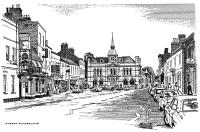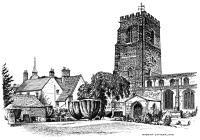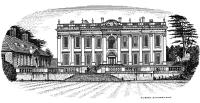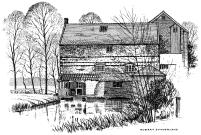Click on the images to enlarge.
Text ©1986,2003 Towcester History Society
Drawings ©1986 Robert Sunderland

 Towcester, the site of the Roman military town of Lactodorum, fell into disrepair when the Romans left Britain. In 998 it was refortified by the Saxons during their conflict with the Danes. The Normans were the next to leave their mark by rebuilding the Saxon church for the good of the soul of the Conqueror. During the Civil War the town, the only Royalist stronghold in Northamptonshire, suffered the attentions of both sides. In more peaceful tunes it became an important posting town on the main coaching route to Holyhead and Ireland.
Towcester, the site of the Roman military town of Lactodorum, fell into disrepair when the Romans left Britain. In 998 it was refortified by the Saxons during their conflict with the Danes. The Normans were the next to leave their mark by rebuilding the Saxon church for the good of the soul of the Conqueror. During the Civil War the town, the only Royalist stronghold in Northamptonshire, suffered the attentions of both sides. In more peaceful tunes it became an important posting town on the main coaching route to Holyhead and Ireland. The Church, dedicated to Saint Lawrence, occupies the site of a Roman basilica and a previous Saxon church. This venerable building has witnessed more of English history than any other in the town. Its rebuilding in honour of Saint Wandregisile was started in the 11th Century by order of William the Conqueror, and it is the handiwork of many craftsmen from then until the present day. Its most famous incumbents were Benedetto Gaetani who became Pope Boniface VIII patron of the great Florentine artist Giotto, and Archdeacon William Sponne the town's great benefactor.
The Church, dedicated to Saint Lawrence, occupies the site of a Roman basilica and a previous Saxon church. This venerable building has witnessed more of English history than any other in the town. Its rebuilding in honour of Saint Wandregisile was started in the 11th Century by order of William the Conqueror, and it is the handiwork of many craftsmen from then until the present day. Its most famous incumbents were Benedetto Gaetani who became Pope Boniface VIII patron of the great Florentine artist Giotto, and Archdeacon William Sponne the town's great benefactor. Easton Neston House, Towcester, was built around 1702 for Sir William Fermor by Nicholas Hawksmoor. Previously clerk of works to Sir Christopher Wren, it was Hawksmoor's first original work and a masterpiece of design for the smaller country mansion. The house, built of Helmdon stone, has weathered very well over the years. It stands in pleasant gardens with a large ornamental pond and a Seventeenth century temple.
Easton Neston House, Towcester, was built around 1702 for Sir William Fermor by Nicholas Hawksmoor. Previously clerk of works to Sir Christopher Wren, it was Hawksmoor's first original work and a masterpiece of design for the smaller country mansion. The house, built of Helmdon stone, has weathered very well over the years. It stands in pleasant gardens with a large ornamental pond and a Seventeenth century temple. Church Mill and Millhouse stand in one of the quiet corners of Towcester. The old part of the mill, disused for many years, bears the date 1799 and with the Mint House in Park Street is virtually all that remains of evidence of the trades and callings of previous times. Long gone are the lace makers, iron workers,farriers and leather workers of Towcester. A mill stood on this site when Domesday was recorded. The present building, badly damaged by fire in 1911, still fills a useful purpose housing high technology businesses. [in 1986 it was used as workshop and showroom for dealers in antique furniture.]
Church Mill and Millhouse stand in one of the quiet corners of Towcester. The old part of the mill, disused for many years, bears the date 1799 and with the Mint House in Park Street is virtually all that remains of evidence of the trades and callings of previous times. Long gone are the lace makers, iron workers,farriers and leather workers of Towcester. A mill stood on this site when Domesday was recorded. The present building, badly damaged by fire in 1911, still fills a useful purpose housing high technology businesses. [in 1986 it was used as workshop and showroom for dealers in antique furniture.]